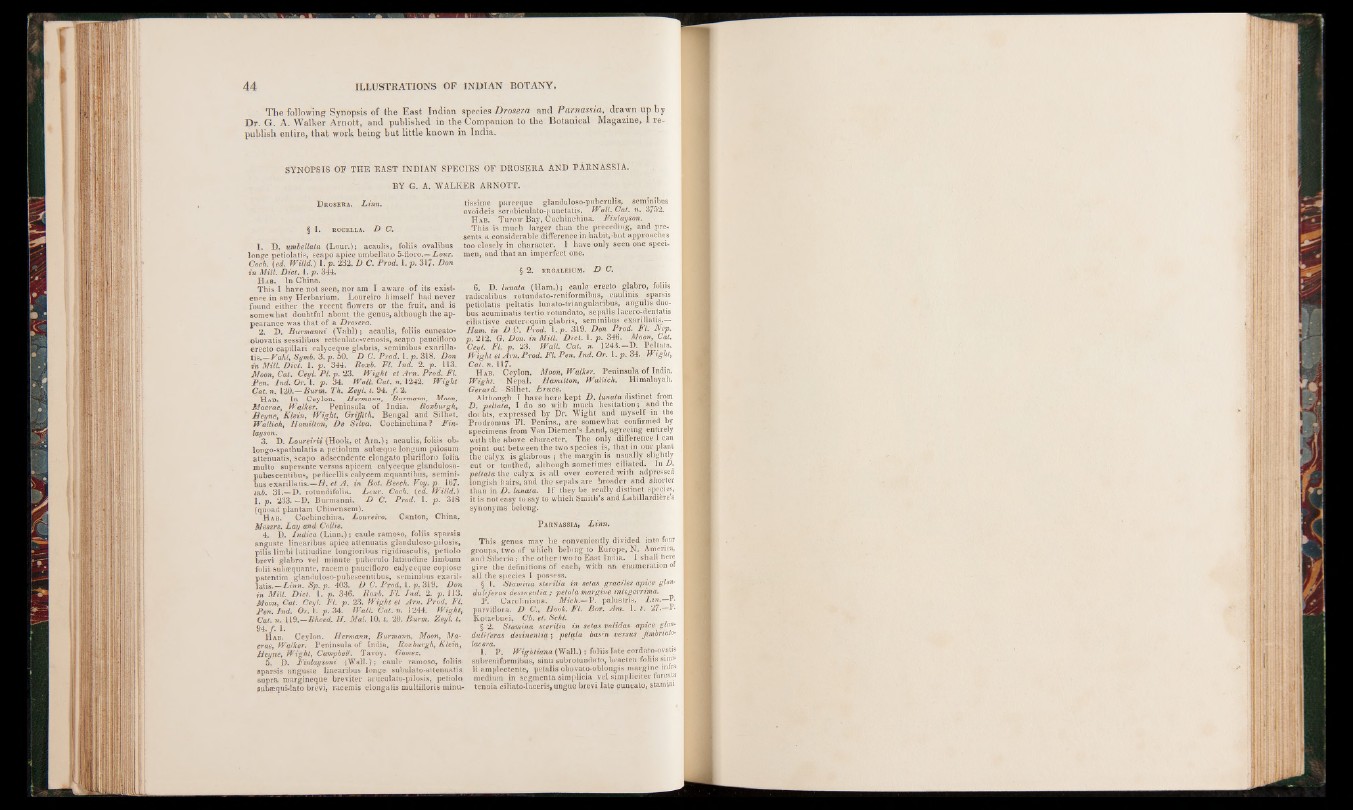
The following Synopsis of the East Indian species Drosera and Parnassia, drawn up by
Dr. G. A. Walker Arnott, and published in the Companion to the Botanical Magazine, 1 republish
entire, that work being but little known in India.
SYNOPSIS OF THE EAST INDIAN SPECIES OF DROSERA AND PARNASSIA.
BY G. A. WALKER ARNOTT.
Drosera. L in n .
§ 1. rocella. D C.
1. D. umbellata (Lour.); acaulis, foliis ovalibus
longe petiolatis, scapo apice umbellato 5-floro.— Lour.
Coch. \ed. fVilld.) 1. p. 232. D C. Prod. 1. p. 317. Bon
in Mill. B i d . 1. p . 344.
Hab. In China.
This I have not seen, nor am I aware of its existence
in any Herbarium. Loureiro himself had never
found either the recent flowers or the fruit, and. is
somewhat doubtful about the genus, although the appearance
was that of a Brosera.
2. D. Burmanni (Y ahl); acaulis, foliis ouneato-
obovatis sessilibus reticulato-venosis, scapo paucifloro
erecto capillari calyceque glabris, seminibus exarilla-
t i s Vahl, Syjnb. 3. p. 50. B C. Prod. 1. p. 318. Bon
in Mill. B i d . 1. p. 344. Roxb. FI. In d . 2. p. 113.
Moon, Cat. Ceyl. Pl. p . 23. W ig h t et Arn. Prod. Fl.
Pen. In d . Or. 1. p. 34. Wall. Cat. n. 1242. W ig h t
Qat. n. 120.— Burm. Th. Zeyl. t. 94. f . 2.
Hab. In Ceylon. Hermann, Burmann, Moon,
Macrae, Walker. Peninsula of India. Roxburgh,
Heyne, Klein, Wight, Griffith. Bengal and Silhet.
Wallich, Hamilton, B e Silva, Cochinchina ? Fin-
lay son.
*3. D. Loureirii (Hook, et Arn.); acaulis, foliis ob-
lono-o-spathulatis a petiolum subeeque longum pilosum
attenuatis, scapo adscendente elongato plurifloro folia
multo superante versus apicem calyceque glanduloso-
pubescentibus, pedicellis calycem aequantibus, seminibus
exarillatis.—H, et A , in Rot. Beech. Voy. p. 167.
mb. 31.—D. rotundifolia. Lour. Coch. (ed. Wil'ld.)
1. p. 233. —D. Burmanni. B C. Prod. 1. p . 318
(quoad plantam Chinensem).
Hab. Cochinchina. Loureiro. Canton, China.
Messrs. Lay and Collie.
4. D. Indica (Linn.); caule rampso.,. foliis sparsis
anguste linearibus apice attenuatis glanduloso-pilosis,
pilis limbi latitudine longioribus rigidiusculis, petiolo
brevi glabro vel minute puberulo latitudine limbum
folii subeequante, racemo paucifloro calyceque copiose
paten tim glanduloso-pubescentibus, seminibus exarib
latis.—L in n . Sp. p. 403. B C. Prod, 1. p. 319. Bon
in Mill. B i d . 1. p. 346. Roxb, FI. In d . 2. p. 113.
Moon, Cat. Ceyl. FI. p. 23. Wight et Arn. Prod. FI.
Pen. In d . Or. 1. p. 34. Wall. Cat. n. 1244. Wight,
Cat. n. 119.—Rheed. H . M a i 10. t. 20. Burm. Zeyl. t.
94. f. 1.
Hab. Ceylon. Hermann, Burmann, Moon, Macrae,
Walker. Peninsula of India. Roxburgh, Klein,
Heyne, Wight, Campbell. Tavoy. Gomez.
5. D. Finlaysoni (.Wall.); caule ramoso, foliis.
sparsis anguste linearibus longe subulato-attenuatis
supra margineque breviter articulato-pilosis, petiolo.
pubaequirlato brevi, racemis elongatis multifloris minutissime
parceque glanduloso-puberuiis, semimous i
ovóideis scrobiculato-punctatis. . Wall. Cat. n. 3752.
Hab. Turow Bay, Cochinchina. Finlayson.
This is much larger than the preceding, and pre- I
sents a considerable difference in habit,-but approaches I
too closely in character. I have only seen one speci- I
men, and that an imperfect one.
§ 2. ERGALEIUM. B C.
6. D. lunata (Ham.); caule erecto glabro, foliis I
radicalibus rotundato-reniformibus, caulinis sparsis I
petiolatis peltatis lunato-triangularibus, angulis duo- I
bus acuminatis tertio rotundato, sepalis lacero-dentatis I
ciliatisve caeteroquin glabris, seminibus exarillatis.— I
Ham. in D C. Prod. 1. p . 319. Bon Prod. FI. Nep. I
p. 212. G. Bon. in Mill. B ie l. 1. p. 346. Moon, Cat. I
Ceyl. FI. p. 23. Wall. Cat. n. 1243.—D. Peltata. I
Wight et Arn. Prod. FI. Pen. In d . Or. 1. p. 34. Wiglil, I
Cat. «. 117. _ _ .. Hab. Ceylon. Moon, Walker. Peninsula of India. ■
Wight. Nepal. Hamilton, Wallich. Himalayah, I
Gerard. Silhet. Bruce. '
Although I have here kept B . lunata distinct from I
B . peltata, I do so with much hesitation; and the I
doibts, expressed by Dr. Wight and myself in the I
Prodromus FI. Penins., are somewhat confirmed by I
specimens from Yan Diemen’s Land, agreeing entirely I
with the above character, The only difference I c.an I
point out between the two species is, that in our plant I
the calyx is glabrous ; the margin is usually slightly I
cut or toothed, although sometimes ciliated. In D. I
peltata the calyx is all over covered with adpréssed I
lemgish hairs, and the sepals are broader and shorter I
than in B . lunata. If they be really distinct species, I
it is not easy to say to which Smith’s and Labillardière s I
synonyms belong.
Parnassia, L in n .
This genus may be conveniently divided into four I
groups, two of which belong to Europe, N . America, I
and Siberia; the other two to East India. I shall here I
give the definitions of each, with an enumeration of I
all the specie,s I possess. ^ I
§ I. Stamina ster ilia in set as graciles apice glan- I
dulifera e desinpnlia ; peta/a mar g iv e integerrima. I
P. Carol'iniana. Mich.—V. palustris. L in .—P. I
parviflora, B C., Hook. FI. Bor. Am. 1. t. 27- P* I
Kotzebuei, Ch. el. Schl.
§ 2. Stamina a ter ilia in setas validas apice glan- I
dullferas deeinentia; pelftla batt’n versus Jimbriato- I
lacera. - I
1. P. Wightiana (Wall.) ; foliis late cordato-ovatis I
subreniformibus, sinu subrotundato? brae tea foliis si rot* I
li amplectente, petalis obovato-oblóngis margine infra I
medium in segmenta simplicia vel simp licit er furcata I
tenuia ciliato-laceris,. ungue brevi late puneato,. stamini I